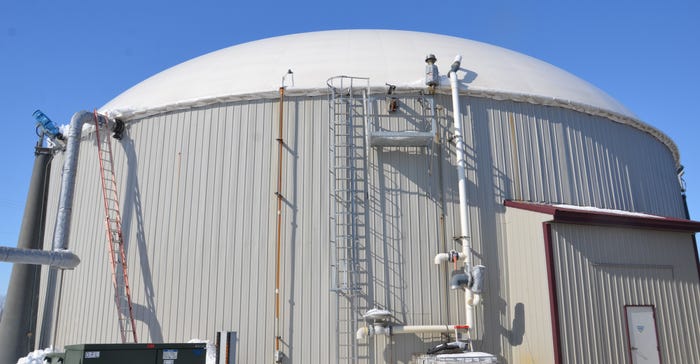
Drive into the country near Monticello, Ind., and you will find a business location that looks like anything except an integral part of a farm operation. The sign says “Waste No Energy.” It’s a corporation set up to operate a methane digester, and today it’s owned and operated by the Roach family, including Rick, son Richard and son-in-law Kyle Dyer.
“This facility opened in 2013, but planning began well before that,” Richard says. In fact, planning for the methane digester project started when Rick was partners with neighbors Ervon Arthur, Dave Klimer and Doug Radersdorf in the farming operation. Each of those men was instrumental in helping the methane digester project get off the ground and succeed, Rick says. They began exiting the partnership in 2015 and are no longer involved.
With training in engineering, Richard is the family member who works most closely with the methane digester today. It’s staffed on-site by one employee, David Kennedy.
“We utilize manure from our cattle and hog operations,” Richard says. “The methane digester is one of the few things in agriculture where we know in advance what we will receive for the product. Having a set income adding to the revenue stream of the farm is a plus when it comes to financial management.”
The end product, electricity, is sold to a large regional utility company. The price is set in advance. Normally, the contract covers 10 years or more. Richard notes that the facility produces enough electricity to power around 940 homes.
Making it work
Industrial food waste from large food companies augments solid cattle manure and liquid hog manure from the Roach operation. Several tankers of liquid food waste arrive at the facility daily.
The digester isn’t located near any livestock facilities. Instead, it’s surrounded by cropland. Manure is transported to the facility and stored in a large building housing tanks and operating equipment. Waste is piped into a large, circular digester with a domed roof. That’s where bacteria work. Richard notes that the solid cattle manure provides bacteria to keep the digester operating correctly.
Power is generated by a mammoth 20-cylinder, methane-powered engine, housed in its own structure. Liquid left over after methane production is stored in a large, aboveground lagoon on-site. The product in the lagoon is applied on cropland.
“We’re able to reduce use of commercial fertilizer significantly,” Richard says. “We test for nutrient content and apply based on soil tests. Our goal is to get it on as many crop acres as possible.”
About the Author(s)
You May Also Like




